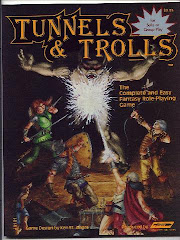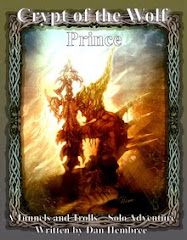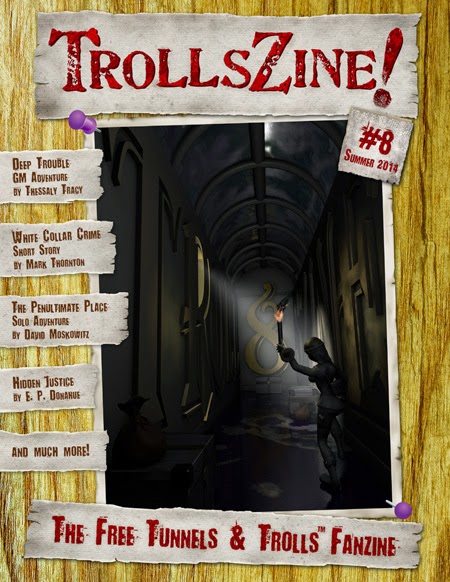After weeks of resting, carousing, and resting some more Itash the Grim was once again feeling the itch of adventure. Riches were awaiting him in Buffalo Castle. He merely had to make the trek back to that haunted fortress to claim them from whatever foul beasts lie within.
Itash had not been completely lazy, however; he had been carving wooden rings. He had heard that such trinkets could be enchanted with simple magic, magic he knew, to increase his own powers. He meant to try that out.
"Alright, I'll go," Istash said finally to no one. He quickly finished his ale, dropped a silver coin on the table and walked out the door. Once outside, Itash pulled out one of his wooden rings and concentrated on it; with a few words the ring glowed with a strange energy. Itash chuckled and slipped on the ring. Knowing the way, Itash strode out of town toward Buffalo Castle.
Name: Itash the Grim
Type: Wizard
Kin: Human
Level: 1
ST 14
IQ 14
LK 14
CON 9
DEX 12
CHR 10
ADDS +4
Treasure: 295 sp, 525 gp, 1 jewel (300 gp), 1 ruby (1000 gp)
Adventure Points: 393
Weapons: Kukri (2D+5, 20 wu, 15 yd), Haladie* (2D+9, 15 wu, enchanted), Common sling w 100 stones (2D+0, 60 wu, 100 yds)
Armor: Back and breast (5 hits, 200 wu), Greaves (2 hits, 40 wu), Gauntlets (2 hits, 25 wu), Greek helm (2 hits, 35 wu) [Total 11 hits, 300 wu]
Equipment: Warm clothing and pack, calf high boots, 5 torches, 20' silk rope, Delvers package, 1 days provisions, 5 wood rings
Weight carried: 455/1400
Languages: Common, Elven
Magic: Detect Magic, Knock knock, Lock Tight, Will-o-wisp, Oh There It Is, Take That You Fiend, Vorpal Blade, Oh-Go-Away, Hocus Pocus, Teacher
A short hike brought Itash back to the all-too-familiar castle. Faced once again with three doors Itash decided to try his luck with the right-hand door. Feeling confident, Itash opened the door and stepped through (L1SR on LK, rolled 3, failure)...then the floor fell out from beneath him sending Itash to the bottom of a pit. Stunned but still alive, Itash rose to his feet and started to look around for a way out. A quick search of the walls revealed no hidden passages, but the stones were set loosely enough to provide finger and toe holds. Perhaps he could climb out? Setting himself to the task, Itash secured his gear and began to climb. Luck and skill were with him for soon Itash was back on the surface and inside Buffalo Castle.
Itash quickly checked his equipment to make sure everything was there, then drew his two daggers and began to examine his surroundings. Itash was in a large chamber with doors leading north and east. The room was empty with the exception of a large fountain in the middle of the floor. The fountain was spraying water majestically into a large basin. Itash was thirsty; the climb out of the pit had been taxing. But this was a magical castle. Perhaps the water was cursed? Or maybe it was blessed? Itash took a scoop of water with his hand and drank deeply. The water filled his stomach with an amazing warmth; he felt better than he had in his entire life. Boundless energy was his (+6 to CON!). Itash laughed heartily and finished his drink. "What's next?" he asked. Deciding on a straight path, Itash opened the northern door.
The room beyond was full of killer bees! Three swarms (MR 10 each) descended on Itash as soon as he stepped into the chamber. Itash cleaved the air with his daggers but the bees were too thick to stop. Most only stung steel, but one delivered a painful sting to his flesh at a joint in his armor (Lost 31 to 37, armor absorbed all hits, took 1 point spite). The pain of the sting enraged Itash and he struck out furiously with his daggers. Bees fell to the ground hacked in two (Won 39 to 32, delivered 2 spite). From there it was soon over, but Itash was once again stung by a lucky bee (Won last 2 turns, 31 to 24 and 37 to 23, took 1 spite). This delve was getting dangerous. Itash made a quick search of the room but found nothing valuable. There was only a door to the north and the way back south. Absently rubbing his stings, Itash made his way north.
The door opened into a corridor leading north. Itash followed the corridor but soon halted at a door in the west wall. The corridor continued north, but Itash decided to investigate. The chamber beyond stank of a sewer. The fetid water on the floor suggested that it may in fact be the castles sewer. Of course no sewer is without rats and this one had three of them; giant ones. The giant rats (MR 12 each) squealed at the sight of Itash and attacked. As the rats charged, Itash unleashed a bolt of energy through his wooden ring (Cast TTYF, L1SR on LK for makeshift wand, rolled 6, success, 14 hits) and blasted one of the rats to a red mist before it could close. With daggers ready, Itash met the charge of the remaining two rats. Itash stepped quickly aside and let the rats blunder past him. As one rat moved alongside him, Itash slashed it with his haladie (Won 29 to 22). The rat staggered and desperately tried to stay on it's feet. That was all the edge Itash needed; in a matter on minutes both rats were dead (Won two turns 32 to 19 and 29 to 7). Itash did his best to search the sewer but found nothing of value, only another door leading further to the west. Grunting at his misfortune thus far, Itash returned to the corridor and continued on his way north.
Itash soon came to yet another door in the western wall. Did he dare try another side passage? He did. Opening the door, Itash saw a nondescript room with a nondescript chest sitting in the middle of the floor. Entering cautiously, Itash prepared to open the chest. There was a quick flash of light and the chest vanished! But all of a sudden Itash felt quite lucky to be alive (+3 to Luck!). Another door lead to the west, but Itash was now quite happy with his northward path. Whistling a tune, he returned down the corridor.
Itash walked along the corridor (L1SR on LK, rolled 5 success) until it opened into a large chamber. Inside he saw a lady sleeping on a couch, her back to him. A dresser nearby the couch held a wonderful jeweled bracelet. But what really caught Itash's eye were the very lifelike statues scattered around the room. They were all dressed in a manner very similar to himself. "This is not good," Itash though to himself as he studied the sleeping woman from a comfortable distance. "Very suspicious looking lady." Itash stood and considered his options. Clearly the woman was bad news, otherwise why would she be here surrounded by foul creatures. There was also the bracelet. He could try to steal it, but he was not the most stealthy person. Best just to slay this creature in her sleep and rid the world of her. "She's likely a gorgon anyway," he thought. Dagger in hand, Itash crept quietly into the room (L1SR on LK, rolled 6, success) and plunged the blade through the creatures back piercing her heart. As the creature expired, Itash caught a glimpse of her serpentine hair. "Yep, gorgon." Without looking back Itash stepped over to the dresser, plucked the bracelet from the surface, and quickly left the room. Once safely in the outer corridor, Itash examined the bracelet. It was a thing of beauty; a masterpiece of gems and gold. He could easily get 500 gp for the piece of jewelry, more than enough to make this trip worthwhile on it's own.
Itash made his way back south (L1SR on LK, rolled 8, success) until he came to the chamber that was previously filled with bees. In the middle of the room now, barring any further progress, was a giant snake (MR 16). "Too big to kill with one spell," Itash thought. "Better use steel." The snake was not even a challenge. As soon as it lunged forward to strike, Itash sliced it's head off with one stroke (Won 34 to 10).
Itash stepped over the writhing carcass of the snake and back to the fountain room. He then tried the door leading east. Itash found himself in an east-west passage (L1SR on LK, rolled 5 success). Heading east, Itash soon found himself at a north-south passage. Itash tried the south passage which quickly jogged back to the east. The corridor led Itash to a room filled with smoke. The smoke did not seem to affect his breathing, but it made it hard to see. Itash groped around the room until he finally found a door in the north wall.
Opening the door Itash found himself in a corridor that bent to the east with a door in the western wall. Itash opened the door to the west and stepped into the chamber beyond. A large pool of water lay in the center of the chamber. What was most interesting, however, was that gold coins littered the floor around the edge of the pool. Itash approached the pool and plucked a coin from the floor. Suddenly eight tentacles erupted from the water. Two lashed out at Itash, who barely had time to draw his daggers. Itash ducked under one of the tentacles then straightened and loped the other in half with his kukri (Won 35 to 18). A third tentacle joined the fight. Itash managed to slice off both tentacles from the body of the giant octopus that now began to rise out the pool, but not before one of them gave him a nasty bruise across the forehead (Won 35 to 14, took 1 spite). The octopus continued to attack, adding one tentacle at a time. Each time a new tentacle lashed out, however, Itash chopped it off (Won all subsequent combat turns, took 3 spite). Soon the giant octopus, bleeding profusely from it's severed limbs, sank down into the pool never to rise again. Itash took a moment to bandage the several minor wounds he suffered in the fight then set about gathering up the gold coins. In all he gathered 20 coins. "It looked like more from the door," he said grudgingly. Looking around the chamber Itash saw doors leading west and back to the east. Itash opted for the western door.
Itash stepped into a north-south corridor that looked familiar. Setting off north, Itash stopped at yet another door in the eastern wall. "One last good score," he said, "then perhaps I'll get out of here." Opening the door, Itash was surprised to step out onto a grassy plain. In front of him a large herd of buffalo was charging right toward him.
"What?" he said in alarm. Readying his daggers, Itash starting slashing at the buffalo as they approached (MR 15 each). Three fell before him before the rest gave him a wide berth, but not before Itash suffered yet another small injury as a buffalo stomped on his foot as it fell (took 1 spite). A new door stood on the opposite side of the plain, but Itash chose to return the way he came. Limping ever so slightly, Itash continued his exploration north.
After a short walk, Itash arrived at a four-way intersection. "Stay north," Itash said to himself and continued on his way. Very shortly afterward Itash arrived at yet another four-way intersection. Hanging down from the ceiling, blocking his way was a giant spider (MR 16). The spider dropped to the floor and rushed Itash, forcing him back against a wall and into the spiders web (L1SR on LK, rolled 7, success). Itash stopped just in time and avoided getting caught in the web. The spider proved no match for Itash, and it was soon crumpled up on the hall floor (Won 42 to 15). Itash searched around the intersection hoping to find a jewel or at least a few coins but came up empty again. Forced to choose a direction yet again, Itash pushed on north. This led him to a three way intersection with new passages leading east and northwest. The northwest passage curved around to the south until Itash came to a door in the east wall. Opening the door, Itash entered a short passage that led east. Following the passage Itash came back to the intersection where he had just killed the giant spider. "I'm walking in circles," Itash grumbled. "I must have lost too much blood."
Itash went back to the north and then east at the three-way intersection. This led Itash to an intersection with a north-south corridor. As Itash entered the intersection he turned to see a large ogre stalking down the northern tunnel. The ogre (MR 20) saw Itash and charged. Itash killed the ogre quickly (Two turns, won 38 to 22 and 32 to 6) but managed to get clocked in the knee by the ogre's thumb (took 1 spite). Searching the ogre's body turned up nothing of value.
Itash trudged north to see where the ogre had come from. The passage turned to the west and then Itash stopped dead in his tracks as he saw a razor-sharp pendulum swinging back and forth effectively blocking the way. Whatever was beyond such a trap had to be good, Itash thought. Better try to get past it. Steeling himself, Itash watched the pendulum swing back and forth, back and forth. He then darted through (L1SR on DEX, rolled 6,6,2,1, success!) and made it across without a scratch. Breathing a quick sigh of relief and a briefer thanks to the gods, Itash walked toward an open doorway.
Walking through the doorway Itash found himself in a treasure room! Gold coins were strewn everywhere! At last! Laughing hysterically, Itash opened his pack and began filling it with coins. But alas, Itash had only collected 50 gold coins before trouble arrived. A mummy staggered into the treasure room through the open doorway. As it entered, all of the coin still on the floor vanished! "Nooooo!!!" Itash screamed and blasted the mummy with a bolt of arcane fire (Cast TTYF, 14 hits). The spell all but obliterated the mummy. Itash strode up the to staggering corpse and drove his dagger through it's head. "Bastard." As Itash kicked the body, he heard a faint jingle of metal. Rolling over the mummy he found a pouch; inside were 70 silver coins; not enough to replace the hundreds of gold coins that he just lost, but it was something.
Having had quite enough with Buffalo Castle, Itash decided that it was time to leave. No sooner had he thought this than he found himself standing in front of the door leading outside. The only thing between him and a cold pint of ale was a giant jellyfish (MR 10). Itash had faced one of these creatures before and he knew how to kill it. His daggers sliced through the sticky flesh with no trouble and soon the jellyfish was reduced to a quivering pile of goo. After cleaning the sticky mess off of the blades of his daggers, the wizard was soon back out into the fresh air.
A sense of elation fell over Itash. He had survived the horrors of Buffalo Castle three times and he had emerged luckier, healthier, and more skilled than before; not to mention richer. The Guild would certainly want to hear of his exploits and he now had the ability and the money to learn some new magic. Itash felt much less grim and smiled the entire way back to town.
----------------------------------------------------------
Itash earned 877 Adventure Points for this foray through Buffalo Castle, more than enough to bring him to the second level. He also picked up another 577 gp in treasure, enough to pick up a shiny new second level spell and still have money left over for room and board for quite some time. In fact, with the gains from his previous expeditions Itash could acquire a total of five second level spells. In addition, Itash had his Constitution permanently increased by 6 and his Luck permanently increased by 3 over the course this adventure. All of these achievements will make Itash quite formidable.
I think that Itash is finished with Buffalo Castle; he has explored most of the monster-infested halls with the exception of a few and he certainly needs more of a challenge. I've managed to put together a rather nice map of the layout. I'll post some commentary on this classic solo a little later. I must say that I enjoyed it immensely and it is quite suitable for any character type.
One final note, I incorporated the use of spite damage in this run through Buffalo Castle to see how Itash would fare with this rule in place. He took a total of 10 hits to his Constitution from spite. That's quite a bit, and enough to kill him with his initial starting CON of 9. Gaining an additional 6 points of CON in the first room he entered, however, gave Itash the motivation and ability to go further. Otherwise he would have exited the castle much sooner.





















